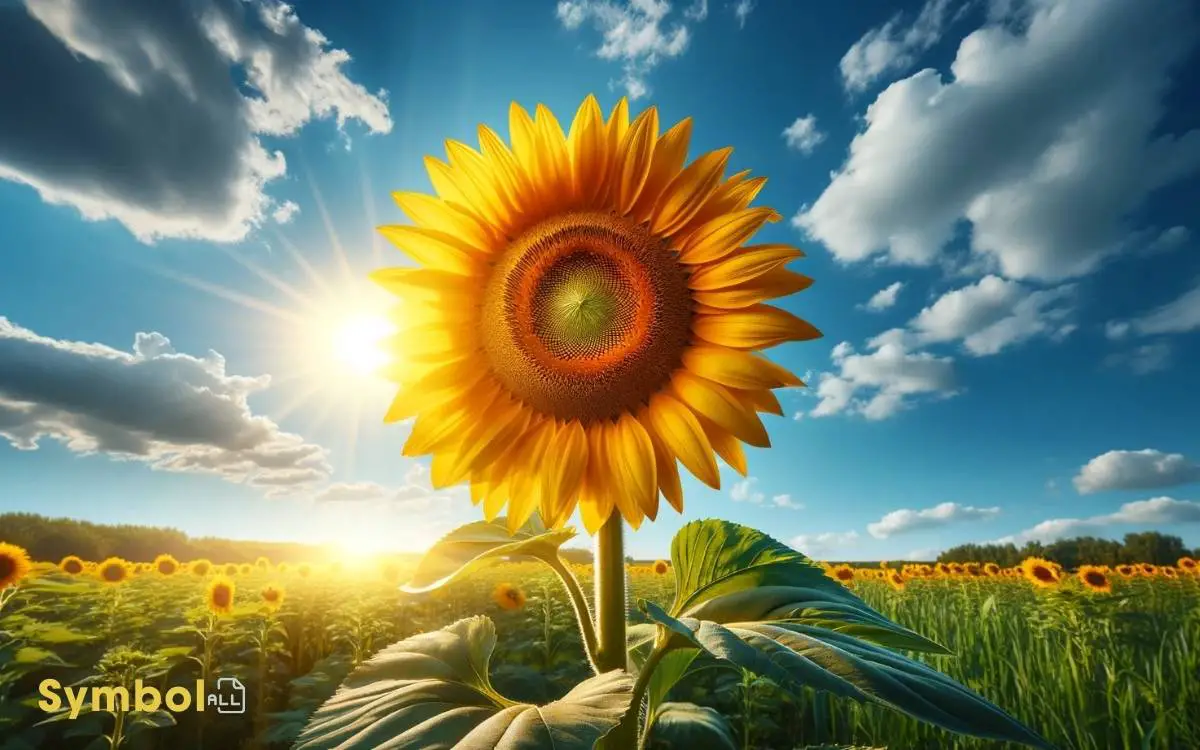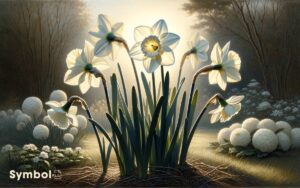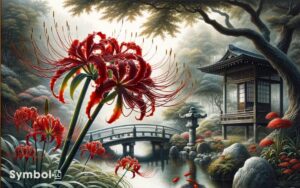What Flower Symbolizes Growth and Progress? Sunflower!
The lotus represents your journey through adversity toward progress. It thrives in stagnant environments, producing pristine flowers, showcasing resilience. Its stem aids buoyancy, embodying growth against odds.
With superhydrophobic properties, the lotus symbolizes untouched progress. Similarly, the sunflower, by following the sun, demonstrates focused growth.
The cherry blossom’s ephemeral beauty and the daffodil’s resilience highlight renewal and new beginnings.
Bamboo’s quick recovery and strong roots illustrate unyielding progress. Exploring these symbols further reveals the intricate tapestry of natural resilience and growth ingrained in our world’s floral diversity.

Key Takeaways
The Symbolic Lotus
Emerging from murky waters, the lotus symbolizes remarkable growth and resilience, illustrating how adversity can lead to beautiful outcomes.
This aquatic plant thrives in stagnant, muddy environments, yet it produces pristine flowers that are untouched by the filth.
Scientifically, the lotus’s ability to rise above the water’s surface is facilitated by its unique stem structure and leaf composition, which possess air spaces that provide buoyancy.
Additionally, the lotus leaf exhibits superhydrophobic properties, meaning it repels water, allowing it to remain clean and dry.
This phenomenon, known as the lotus effect, has inspired numerous applications in materials science.
The lotus’s lifecycle, from seed to flower, mirrors personal growth and enlightenment, serving as a metaphor for overcoming obstacles and emerging stronger.
Sunflower: A Tale of Adoration
You’ll find that the sunflower’s association with growth and progress isn’t accidental but deeply rooted in its biological and symbolic characteristics.
The mechanism through which sunflowers track the sun, known as heliotropism, exemplifies growth driven by adoration for the sun.
Analyzing this phenomenon provides insight into how adoration, much like the sunflower’s orientation towards light, fuels its robust growth and symbolizes unwavering focus and progress.
Sunflower Symbolism Explored
In the domain of flora, the sunflower stands as a fascinating emblem of adoration, reflecting intricate biological mechanisms and deep-seated cultural significances.
This towering plant, characterized by its large, bright blooms that turn to follow the sun, symbolizes loyalty and unwavering faith due to its heliotropic nature.
Scientifically, this behavior maximizes photosynthesis efficiency, showcasing an evolutionarily advanced strategy for growth.
Culturally, sunflowers have been revered across civilizations, embodying the sun’s power and the concept of adoration towards a nurturing force.
Their presence in art and literature further cements their role as symbols of devotion and admiration.
Growth Through Adoration
Sunflowers captivate not only by their vivid appearance but also through their ability to epitomize growth and adoration, intertwining botanical phenomena with profound emotional significance.
You’ll find their growth fascinating; they exhibit phototropism, an adaptive movement where the flower head tracks the sun across the sky, mirroring the way adoration can inspire one to lean into sources of warmth and enlightenment.
This dynamic growth, fueled by sunlight, symbolizes an enduring pursuit of light and truth, much like the human journey towards personal development and understanding. Scientifically, their heliotropic tendencies facilitate best photosynthesis, enhancing their growth.
This mirrors how adoration and positive focus can foster personal growth, making the sunflower a profound emblem for those seeking progress through admiration and positive orientation.
Cherry Blossom Insights
You’ll find that cherry blossoms represent a spectrum of meanings, from the ephemeral nature of life to renewal and optimism, deeply rooted in various cultures.
These flowers are central to numerous festivals and traditions, illustrating how societies across the globe celebrate the cycles of life and nature.
A detailed examination of these practices reveals the intricate ways in which cherry blossoms are woven into cultural identities, marking periods of reflection and festivity.
Cherry Blossom Symbolism
Why do cherry blossoms symbolize growth and progress?
The answer lies in their lifecycle. Each spring, cherry blossoms burst into spectacular bloom, marking a period of renewal and the beginning of a growth cycle. This ephemeral beauty, however, is fleeting, as the blossoms quickly peak and then fall away.
This cycle mirrors the natural process of growth and decay, symbolizing the transient nature of life and the constant progress inherent in the cycle of renewal.
Scientifically, the blossoms’ peak represents the culmination of growth, a critical phase in the plant’s reproductive cycle.
This stage is essential for pollination and subsequent fruit development, embodying the concept of progress through regeneration. Cherry blossoms are a poignant reminder of the beauty and inevitability of growth and progress.
Celebrations and Traditions
Reflecting on the symbolic growth and progress represented by cherry blossoms, it’s important to explore how these themes are celebrated and ingrained in cultural traditions worldwide.
The cherry blossom, or *Sakura*, particularly in Japan, epitomizes the transient nature of life, a concept deeply embedded in various ceremonies and festivities.
For example, the *Hanami* festival, an annual event, gathers communities under blooming cherry blossom trees to reflect on both the beauty and fragility of existence.
This celebration, dating back centuries, underscores a collective acknowledgment of the cycle of life and death, promoting a philosophical acceptance of change and renewal.
Scientifically, the timing of cherry blossom blooming is meticulously monitored, with its onset signaling the change from winter to spring, further symbolizing new beginnings and the relentless march of time.
The Resilient Daffodil
Amid the early signs of spring, the resilient daffodil emerges as a potent symbol of growth and progress, showcasing its ability to thrive in adverse conditions.
This flower’s resilience and vibrant bloom convey deep meanings:
- Adaptability: Daffodils can grow in a wide range of climates, symbolizing flexibility and the ability to adapt to life’s changes.
- Renewal: They’re among the first flowers to bloom, representing new beginnings and the renewal of nature.
- Resilience: Their ability to withstand cold, often blooming through snow, highlights strength in adversity.
- Hope: The bright yellow color is universally associated with happiness and hope, encouraging optimism.
- Inspiration: Daffodils inspire us to persevere and flourish despite challenges, embodying the spirit of growth and progress.
Bamboo: More Than a Plant
Often overlooked, bamboo serves as a profound emblem of resilience, rapidly growing under diverse conditions and symbolizing strength and versatility in the face of challenges.
| Trait | Significance |
|---|---|
| Rapid Growth | Demonstrates exceptional adaptability and quick recovery. |
| Strong Roots | Symbolizes a solid foundation, ensuring stability. |
| Versatility | Highlights its ability to thrive in various environments. |
| Continuous Growth | Represents unending progress and development. |
Bamboo’s growth pattern is not just a validation of its robustness but also an indicator of its ecological value, playing a pivotal role in environmental sustainability.
Its ability to grow in less-than-ideal conditions without significant aid mirrors the human capacity for resilience and adaptation.
You’ll find that bamboo’s symbolism extends beyond its physical attributes, embodying lessons in persistence and the continuous quest for growth.
Lavenders Tranquil Growth
Lavender’s gentle but steadfast growth embodies serenity, subtly illustrating how tranquility can intertwine with and foster progress in the natural world.
You’ll find its development fascinating, revealing much about the significance of a calm environment for growth:
- Root Depth: Lavender’s roots penetrate deeply, symbolizing a strong foundation necessary for sustained growth.
- Drought Resistance: Its resilience to drought reflects adaptability and the importance of resourcefulness.
- Aromatic Oils: The production of fragrant oils demonstrates how growth can also yield protective and beneficial byproducts.
- Pollinator Attraction: Lavender entices pollinators, underlining the role of cooperation in progress.
- Seasonal Bloom: Its seasonal flowering cycle highlights the natural rhythm of growth and rest, emphasizing patience and timing.
Understanding lavender’s growth patterns enhances your appreciation for how peace and stability contribute to development.
The Evolving Amaryllis
You’ll find the Amaryllis growth cycle fascinating as it encapsulates both the resilience and fragility inherent in nature. Through its phases, from bulb to bloom, the Amaryllis embodies a profound symbolism of growth and progress.
Analyzing this cycle provides insights into how environmental factors and care practices impact its development and metaphorical meanings.
Amaryllis Growth Cycle
The amaryllis bulb starts a captivating growth cycle, characterized by distinct stages of development that highlight its symbolization of growth and progress.
As you explore further into its lifecycle, you’ll appreciate the intricate processes it undergoes:
- Dormancy: A period of rest where energy is conserved for the upcoming growth spurt.
- Sprouting: The emergence of green shoots, signaling the start of active growth.
- Leaf Development: Leaves expand, enabling photosynthesis to fuel further growth.
- Stalk Elongation: A rapid vertical growth phase that precedes flowering.
- Blooming: The culmination of growth, where vibrant flowers emerge, symbolizing achievement and new beginnings.
Each stage in the amaryllis growth cycle reveals the plant’s resilience and adaptability, mirroring the journey of personal growth and progress.
Symbolism in Amaryllis
Amaryllis, through its dynamic growth cycle, embodies profound symbolism, reflecting not just the passage of time but also personal development and achievement.
You’ll find that each stage of the amaryllis’ life, from bulb to bloom, mirrors phases of human growth and the pursuit of goals.
Initially dormant, the bulb, akin to potential lying in wait, bursts into growth under the right conditions. This parallels the idea that with nurturing environments, latent abilities can flourish.
The stem’s steadfast rise, despite its initial fragility, symbolizes resilience and determination. Finally, the bloom, a culmination of patience and care, represents success and fulfillment.
Analyzing the amaryllis’ journey reveals a rich tapestry of symbols for progress, underscoring nature’s inherent wisdom in mirroring life’s own complexities and triumphs.
Gladiolus: Strength in Bloom
Throughout the ages, gladioli have symbolized strength and moral integrity, reflecting their role in natural selection as resilient and adaptive species.
You’ll find that this flower’s significance goes far beyond its aesthetic appeal, offering a deeper understanding of growth and progress:
- Gladiolus plants exhibit rapid growth, indicative of their adaptability to diverse environments.
- Their vertical blossoming pattern represents the continuous upward movement in personal and professional life.
- The variety of colors signifies the multitude of paths to success and fulfillment.
- Strong stems symbolize the robust foundation required for sustained growth.
- The flower’s seasonality teaches the importance of timing and patience in personal development.
Gladioli serve as a potent metaphor for strength and progress, embodying the journey towards achieving one’s goals through resilience and adaptability.
The Progressive Peony
Moving from the robust gladioli, let’s now examine the peony, a flower that encapsulates beauty and growth in its own unique way.
| Feature | Description | Significance |
|---|---|---|
| Bloom Cycle | Late Spring | Symbolizes renewal and the promise of new growth. |
| Color Varieties | White, Pink, Red | Represents love, honor, and prosperity. |
| Lifespan Per Bloom | Up to 10 days | Reflects transient beauty and the importance of cherishing moments. |
| Root System | Perennial | Indicates resilience, stability, and long-term growth. |
| Cultural Significance | Ancient Asian Symbol | Esteemed for its medicinal properties and emblematic of wealth and honor. |
Peonies exhibit a complex interplay of beauty and resilience, mirroring the intricate process of personal growth and development. Their perennial nature and diverse colors emphasize the multifaceted aspects of progress and evolution.
Orchids: Exotic Elegance
In the domain of botanical elegance, orchids stand out for their intricate structures and vast diversity, symbolizing sophistication and refined beauty. These enchanting blooms offer more than meets the eye, reflecting profound meanings and insights.
- Adaptability: Orchids flourish in a range of environments, embodying the ability to thrive under varying conditions.
- Complexity: The intricate life cycle of orchids mirrors the multifaceted journey of growth and progress.
- Resilience: With the capability to bloom again, orchids demonstrate resilience and enduring strength.
- Evolution: Representing one of the largest families of flowering plants, orchids signify evolution and constant adaptation.
- Rare Beauty: The unique appearance of each orchid speaks to the beauty of individual growth and the pursuit of uniqueness in progress.
Understanding orchids’ symbolism enriches the appreciation of their role in symbolizing growth and progress.
The Spirited Snapdragon
Shifting focus to the Snapdragon, this vibrant flower embodies resilience and the power of growth through its ability to snap back after being compressed.
Delving into its botanical essence, Snapdragons, belonging to the genus Antirrhinum, showcase a unique mechanism. When pressure is applied to their sides, they momentarily open, akin to a mouth, before resiliently returning to their original state.
This action symbolizes not just resilience but also the ability to withstand and recover from challenges. Scientifically, this feature is attributed to the specialized structure of their petals and the strength of their cellular composition.
In the context of growth and progress, the Snapdragon represents the capacity to endure adversity, adapt, and ultimately thrive.
Its life cycle, from seed to bloom, further exemplifies the journey of development and the relentless pursuit of blossoming despite obstacles.
Ferns: Ancient and Growing
Countless species of ferns, some dating back over 360 million years, continue to thrive and evolve, showcasing their remarkable adaptability and resilience in the face of changing environments.
These ancient plants symbolize growth and progress through their enduring presence and ability to flourish under diverse conditions.
- Diversity: Ferns exhibit a vast array of forms, adapting to a wide range of habitats.
- Resilience: They’ve survived mass extinctions, demonstrating unparalleled survival skills.
- Adaptability: Ferns have evolved to thrive in both shaded and sunlit environments.
- Growth: They propagate through spores, enabling widespread colonization.
- Regeneration: Many ferns can regenerate from fragments, symbolizing renewal and continuous growth.
These characteristics make ferns a profound emblem of persistence, adaptability, and the capacity for growth and progress.
Roses: Blossoming Love
While ferns symbolize growth and adaptability in nature, roses represent the complex dimensions of love and beauty through their diverse species and intricate bloom patterns.
| Color | Symbolic Meaning | Common Occasion |
|---|---|---|
| Red | Romantic love | Valentine’s Day |
| White | Purity, Innocence | Weddings |
| Yellow | Friendship, Joy | Friendship Day |
| Pink | Gratitude, Admiration | Mother’s Day |
| Orange | Enthusiasm, Desire | Anniversary |
Roses’ ability to signify various emotional states and intentions is rooted in their biological diversity and cultural significance. They’ve evolved to produce a range of colors, each associated with different meanings, enhancing their role in human expressions of feeling.
This adaptability makes roses a versatile symbol for growth in relationships, embodying the progression from budding attraction to blooming love.
The Anemone Journey
Often underestimated, the anemone flower embodies resilience and hope, embodying significant phases of growth and renewal in its lifecycle.
- Steering: Anemones have adjusted to a range of environments, from windy cliffs to tranquil gardens, showcasing their dynamic resilience.
- Sprouting: The anemone’s germination process, requiring stratification, mirrors the necessity of enduring hardships for growth.
- Flourishing Cycle: Their ability to bloom in spring or fall, depending on the species, symbolizes the diverse paths of progress and development.
- Fertilization: The attraction of pollinators illustrates the importance of external factors and relationships in achieving growth.
- Seed Scattering: The methodical spread of seeds highlights the strategic planning required for sustained progress and expansion.
This journey reflects the complexity and beauty of managing growth, offering profound insights into the mechanisms of resilience and renewal.
What is the Meaning Behind Sunflowers as a Symbol for Growth and a Free Spirit?
Sunflowers are often associated with free spirit symbolism and growth due to their ability to thrive in diverse environments and their tendency to turn towards the sun. This resilient flower represents a free-spirited, uplifting nature, mirroring the characteristics of those who embrace personal growth and individuality.
Conclusion
Fundamentally, the flora discussed embodies growth and progress, each with its unique narrative. Like stars in the botanical cosmos, they shine, illustrating perseverance, love, and resilience.
Analyzing these plants reveals a fascinating symbiosis between symbolism and biological adaptation. They’re not merely survivors but thrive under adversity, mirroring life’s own journey.
This scientific exploration uncovers the profound depth of what might seem superficially decorative, showing that, indeed, nature’s designs are both intricate and intentional.






